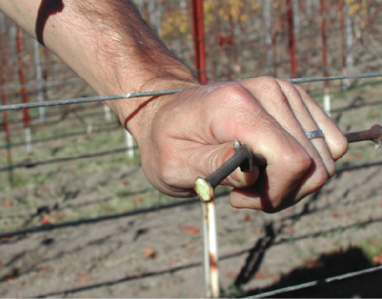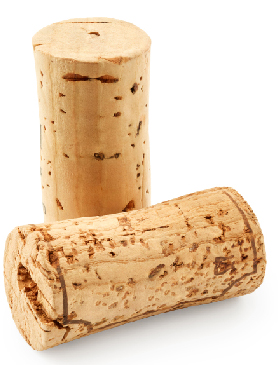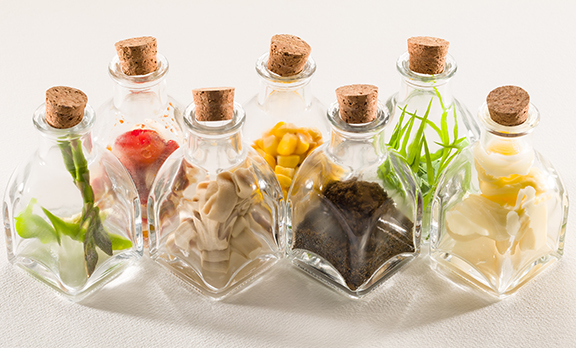
In the June-July 2019 issue we explored some of the most common wine faults you are likely to encounter, whether during your personal winemaking journey or while tasting the wines of others, even commercial wineries. In this edition, we are diving a little deeper into some lesser-discussed faults that, while less common, are nonetheless just as important to be aware of. The faults that follow have been broken into two categories: Pre-bottling faults and post-bottling faults, as some of these can be ameliorated before they go into bottle, whereas others will not demonstrate/develop their characteristics until bottled.
As with the first installment, this article is intended as a primer into the basics of what the included faults are, why they happen, and how to potentially fix them. There is a great deal of information available on how to further manage some of these faults should they arise. As always, prevention is key.
Pre-bottling faults
Diacetyl
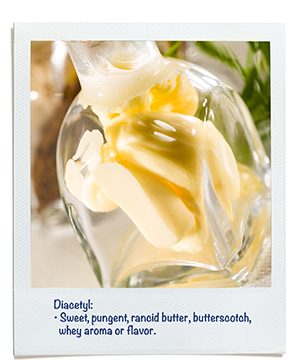
A natural byproduct of malolactic bacterial conversion, diacetyl (2, 3 butane dione) is a chemical compound formed when Lactobacillus Pediococcus, Oenococcus, or Leuconostoc metabolize citric acid. Even at quite high concentrations, diacetyl may be greatly enjoyed by those who are partial to rich, buttery Chardonnays; but excessive amounts take on overwhelming odors. Diacetyl is found specifically in wines that undergo malolactic fermentation (MLF).
Sensory threshold: 100 parts per billion.
Cause: Both yeast and bacteria can cause diacetyl production, though generally yeasts cannot produce excessive amounts of it, whereas bacteria present during malolactic fermentation can. The presence of and amount of citric acid, as well as temperature, pH, and certain bacterial strains can all lead to the overproduction of this compound. Diacetyl is produced when citric acid is metabolized once all of the malic acid has already been converted to lactic acid.
Detection: Sweet, pungent, rancid butter, butterscotch, whey aroma or flavor. It is considered a minor flaw at low concentrations (1–4 mg/L) but at high concentrations (5+ mg/L) the aroma can become odorous and overwhelming.
Prevention: Halt the wine from undergoing malolactic fermentation; you can do this with SO2 additions and by adding lysozyme. If you do want the wine to go through MLF, use specified malolactic bacteria with accurate addition rates and monitor MLF closely so you can promptly add SO2 at the completion of MLF to kill the bacteria before it goes after the citric acid. Yeast metabolize diacetyl, so leave the wine on the lees. Do not add citric acid.
Fix: Blend out with a wine that did not acquire such strong diacetyl aromas. If aging on lees, increase the time the wine spends in contact with lees, as more time in contact will help to break down the diacetyl levels. Transferring a wine with very high diacetyl levels onto another batch of lees may help to neutralize it as well.
Additional note: Diacetyl is most commonly associated with Chardonnay, but can affect other wines that have completed malolactic fermentation as well.
Ropiness
In certain wine conditions, this oily slime layer can be produced by Leuconostoc or Pediococcus as a result of their glucose metabolism.
Sensory threshold: n/a
Cause: Lactic acid bacteria producing dextrins and polysaccharides. The main bacterial strains causing ropiness are Pediococcus damnosus and P. parvulus.
Detection: High viscosity wine sensed as a slimy sensation in the mouth while also maintaining an oily or slimy appearance. You may see its eponymous ropes or strings floating in the wine. Consistency can be likened to egg whites.
Prevention: Sterile filtration, keep pH under 3.5; agitate/transfer the wine as soon as you begin to notice this issue popping up.
Fix: If this fault is noticed while the wine is still in a tank at the winery, transferring it to another tank can oftentimes be the initial, if not the main remedy required. The problem is that this fault usually does not reveal itself until long after it has been bottled. Sterile filtration and SO2 additions should work as well.
Additional note: In French this fault is known as “la maladie de la graisse,” or fat sickness. If this fault does not reveal itself before bottling then it will usually go unnoticed for quite a while. While the wine’s aroma and flavor will not be adversely affected, the mucilaginous quality that the wine acquires is far from pleasant.
Geosmin
A microbial fault often confused for cork taint due to its musty, earthy aromas that can overpower all other characteristics of the wine.
Sensory threshold: Between 0.5–25 ng/L, though detection rates vary, and are often confused with cork taint.
Cause: The growth of Penicillum expansum on Botrytis-infected fruit. P. expansum works symbiotically with Botrytis to allow for the creation of geosmin aromas within the grape clusters. Using corks that have already been compromised by mold can also lead to its presence in a wine even if not detected in the wine before bottling.
Detection: Aromas of freshly tilled earth, muddy, musty, damp cellar, beetroot.
Prevention: Sort grape bunches prior to crushing and/or fermenting so as to exclude moldy or Botrytis-infected clusters. Cooler growing regions as well as damper vintages are more prone to geosmin taint; being aware of this may be helpful in terms of viticultural decisions as methods of prevention can lead to more attentive measures on the sorting table.
Fix: Studies have been conducted in an effort to discover the best methods of removing this problematic and highly odorous compound, including the addition of milk, grapeseed oil, and activated charcoal to the affected wine. The proteins in milk were believed to attract and bind with geosmin, and the oil was believed to function as a solvent for the geosmin. Though these studies did demonstrate a minimization in geosmin concentration, it was also concluded that volatile aroma compounds were depleted, which increased the noticeability of the geosmin that remained. Until studies find a more conclusive method of removing geosmin from wine without stripping it of its additional aromas, it is wise to focus on preventative measures.
Ladybug taint
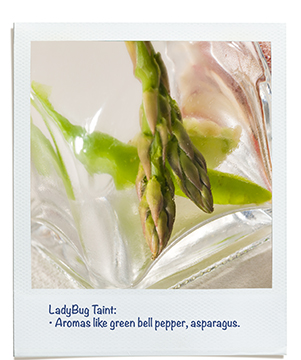
A lesser-known and seemingly esoteric wine issue, ladybug taint is a very real problem that is caused by the Multicolored Asian Ladybeetle (Harmonia axyridis) as well as the seven-spotted ladybeetle (Coccinella septempunctata). The insects secrete a chemical so powerful that an extremely small amount can easily devastate the potential of the vintage if not carefully monitored.
Sensory threshold: 320 pg/L for isopropyl methoxypyrazine (IPMP).
Cause: IPMP is released from ladybugs’ hemolymph during times of stress, such as when they are stuck within a massive amount of grapes or must, or being crushed prior to fermentation.
Detection: Studies have demonstrated that between 1–10 ladybugs per quart/liter of juice will greatly affect a finished wine, due to the overwhelming effects of methoxypyrazines. Aromas of green bell pepper, asparagus, cut grass, as well as rancid peanut butter, earth, and humus are commonly associated with ladybug taint.
Prevention: Vigilant protection of the must from ladybugs — it’s as simple as that. Keep a careful eye out at the sorting table and then extract any ladybugs that arrive at the table with the clusters.
Fix: Addition of oak chips has been known to mask the taint if used at high enough concentrations. However, this remedy is limited in scope, as many wine styles will not require oaking, and over-oaking is not necessarily a positive in many instances either.
Geranium taint
This fault is particular to wines with sorbic acid added to them, as the formation of 2-ethoxyhexa-3,5-diene (crushed geranium leaf aroma) is a consequence of the metabolism of sorbic acid by lactic acid bacteria.
Sensory threshold: 100 ng/L.
Cause: Malolactic bacteria in the presence of potassium sorbate can produce 2-ethoxyhexa-3,5-diene.
Detection: Aroma and flavor of crushed geranium leaves.
Prevention: Do not use potassium sorbate if the wine went through MLF. Sorbate is added to inhibit yeast growth in wines with residual sugar; but do not allow the wine to go through MLF if you are considering keeping some sweetness to the wine. Consider dropping the temperature if you insist on having residual sugar in the wine.
Fix: None known.
Additional note: This taint is not found in must because its formation requires the presence of alcohol. As such, it develops in finished wine.
Dimethyl sulfide (DMS)
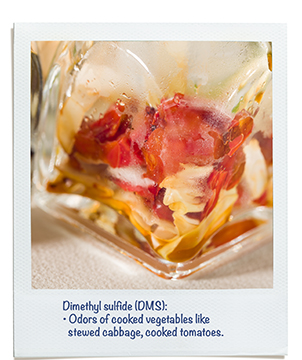
Though it enhances fruit flavors when concentrations are low, this volatile sulfur compound commonly found in wine can ruin aromatics over time if concentrations are too high during its maturation in bottle.
Sensory threshold: 10–20 ppb. Lower concentrations can add fruitiness and complexity; higher concentrations give off a cooked vegetable/cabbage/sulfide odor.
Cause: Likely a breakdown product of amino acids.
Detection: In aged wines, odors of cooked vegetables, cooked corn, stewed cabbage, cooked tomato, truffle, asparagus, and even molasses. Lower concentrations may deliver dark fruit aromatics, which can make it difficult to differentiate as a fault of any kind; in this case, low DMS levels would be serving to benefit the wine by adding fruity characteristics as well as complexity.
Prevention: Early prevention is key, especially since these characteristics often go unrecognized in a wine until it has aged. As with volatile sulfur compounds found in wine, prevention is multifaceted, as sulfur compounds form for a variety of reasons.
Fix: Reverse osmosis. In white wines, disulfides can be treated with ascorbate at 100 mg/L to cleave the disulfide bond. After about two weeks, do copper trials to remove the mono sulfides.
Post-Bottling faults
Heat damage
This is an entirely preventable fault, as it merely requires the winemaker to be vigilant of bottled wine storage temperatures, which should not exceed 65 °F (18 °C).
Sensory threshold: n/a
Cause: Excessive exposure of wine to heat.
Detection: Quality loss, which can be marked or subtle depending on the temperatures and duration it was exposed to elevated temperatures. Oxidative qualities.
Prevention: Store bottled wine at cellar temperatures, ideally as close to 50 °F (10 °C) as possible.
Fix: None.
Light strike (goût de lumière)
Light strike is a common yet preventable fault, where light exposure leads to the premature breakdown of the wine. It primarily affects white and rosé wines as they are often packaged in clear bottles, allowing light damage to occur.
Sensory threshold: n/a
Cause: Excessive light exposure to bottled wine.
Detection: Symptoms akin to premature aging, such as loss of or dulled aromatics, changes in color similar to oxidation (browning of white wines, red wines taking on a lighter brick red color prematurely).
Prevention: Keep bottled wine in a dark, cool place; use dark-colored bottles when possible.
Fix: None.
Refermentation
You are more likely to bring some unwanted microorganisms into the wine you are bottling when conditions are not entirely sanitary. To complicate matters, if there is residual sugar (RS) in this wine, the possibility of refermentation in the bottle increases.
Sensory threshold: n/a
Cause: Non-sterile bottling conditions; bacteria or yeast fermenting residual sugar after the wine has been bottled.
Detection: Undesired/unaccounted for spritzy sensation or carbonation detected in bottled wine; turbidity/cloudy wine, increased alcohol, aromatic changes.
Prevention: Sterile filter, SO2 (for LAB stability), potassium sorbate (but only if it has not undergone MLF; see geranium taint section earlier).
Fix: You will likely need to empty all of the bottled wine in order to sterile filter and rebottle, unless you want to run the risk of popping corks (or bottles).
Additional note: Refermentation can also be associated with MLF occurring in the bottle. If this is the case, a light spritz may or may not be noticeable.


